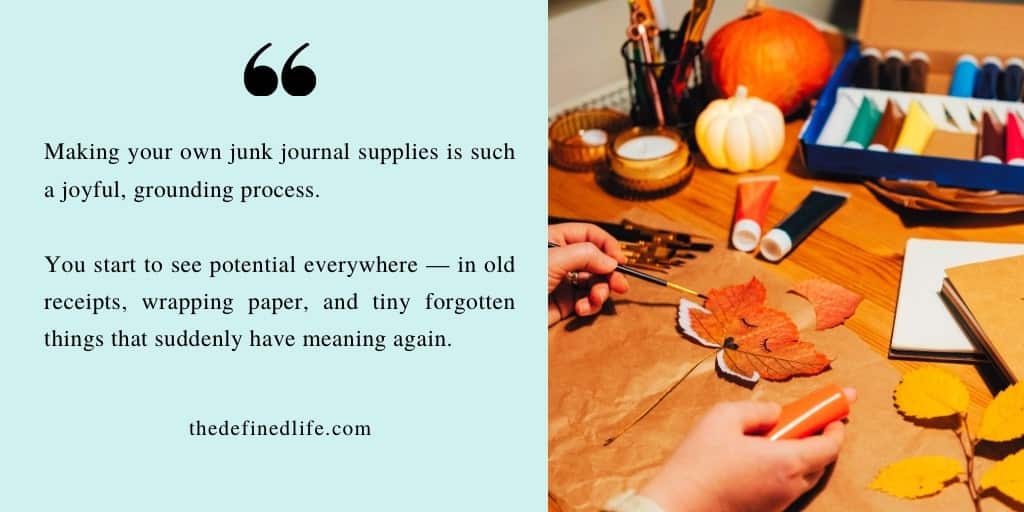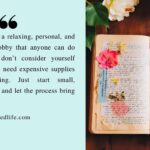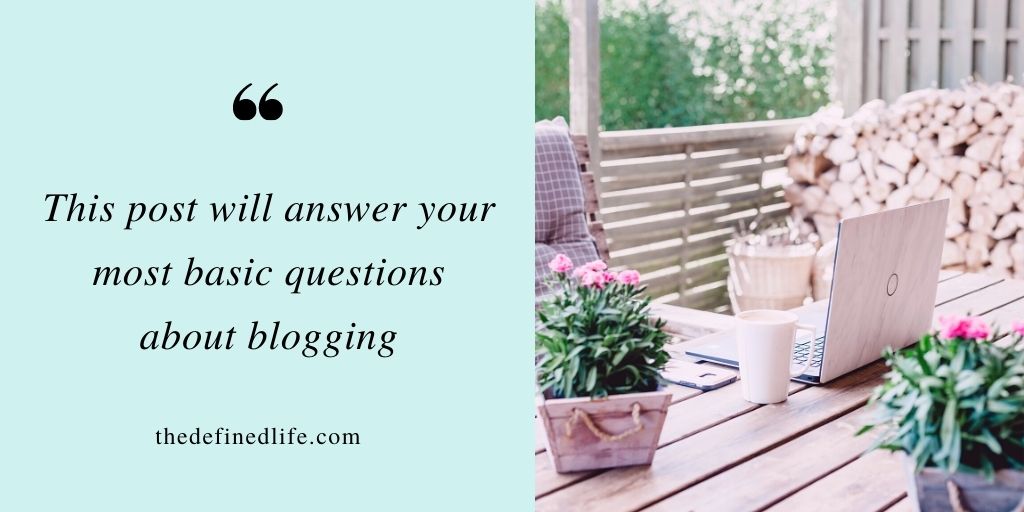
There’s something magical about turning simple scraps into something beautiful and meaningful.
That’s what I love most about junk journaling — transforming the ordinary into pages that tell your story in your own imperfect, wonderful way.
And here’s the best part: you don’t need fancy supplies or a huge craft stash to start.
If you look around your home right now, you probably already have everything you need.
In this post, I’ll walk you through how to DIY junk journal supplies — easy, budget-friendly, and beautiful, everyday materials you can create from what’s already around you.
So, grab your scissors, a cup of tea, and let’s craft together.
Table of Contents
Why DIY Junk Journal Supplies?
There’s something so satisfying about creating your own materials. It’s not just about saving money (though that’s a nice bonus!) — it’s about connection.
When you make your own supplies:
You create pieces that feel deeply personal and unique.
You give old materials a second life — which is eco-friendly.
You add warmth, character, and texture that store-bought supplies just can’t replicate.
DIY Junk Journal Supply Ideas You Can Make at Home
Let’s explore a few simple and creative ways to make your own supplies using everyday things you probably already have.
1. Coffee or Tea-Dyed Paper
This is one of my favorite ways to start — it’s simple, relaxing, and makes your pages look beautifully aged and vintage.
How to make it:
1. Brew a strong cup of coffee or tea.
2. Place plain or scrap paper (book pages, notebook paper, or printer paper) on a tray.
3. Gently brush or pour the liquid over it.
4. Let it air dry, or bake on low heat for a few minutes if you’re feeling impatient.
Try this: Sprinkle a little instant coffee or cinnamon while the paper’s still wet for some extra texture (and a cozy scent!).
A quick note:
If you’re worried about insects — don’t be! Just make sure your papers are completely dry before storing them. You can pop them in the oven for a few minutes on low heat or let them air dry in a sunny spot.
Once dry, keep them in a sealed box or ziplock bag, and they’ll stay beautiful and bug-free.

2. Handmade Tags and Journaling Cards
I love this one because it turns “trash” into treasures. Cardboard boxes, snack packaging, even old mailers can become beautiful tags and journaling cards.
How to make it:
- Cut your cardboard into tag shapes or small rectangles.
- Cover them with old book pages, scrapbook paper, or printables.
- Add a hole punch and thread a ribbon, lace, or twine through it.
Make a few at once — they’re perfect for layering or writing short reflections inside your journal.
3. Collaged Backgrounds
If you have a pile of paper scraps that feels too random to use — this one’s for you.
How to make it:
- Glue scraps, tickets, receipts, or bits of paper onto a blank page.
- Overlap pieces to create a textured, layered look.
- Once it’s dry, cut it up into smaller cards or journaling spots.
It’s like making your own patterned paper — and every collage turns out different, just like every story.

4. DIY Envelopes and Pockets
Pockets add such a cozy, secret touch — little places to tuck away notes, photos, or dreams.
How to make it:
- Take an envelope you already have and trace it onto decorative paper.
- Cut, fold, and glue the edges.
- Add lace, stickers, or washi tape for decoration.
You can even fold book pages or sheet music into small pockets — no templates needed.

5. Fabric & Lace Embellishments
Adding fabric instantly brings warmth and texture. I often use leftover fabric scraps, lace ribbons, or even an old scarf I don’t wear anymore.
Ideas:
- Cut strips of fabric to make tabs or borders.
- Glue or stitch lace along page edges.
- Layer bits of cloth under paper for extra depth.
Tip: Gently fray the edges for that soft, timeworn look that junk journalers love.
You like floral? Check out this post about how to get that vibe using floral junk journal supplies here.💐
6. Repurposed Packaging and Wrapping Paper
Before you toss that wrapping paper or box — look again! Many of them have lovely patterns, typography, or textures that fit perfectly in a junk journal.
Ways to use them:
- Turn tissue paper into collage backgrounds.
- Cut printed cardboard into journal cards.
- Use product tags and labels as ephemera.
- It’s eco-friendly and creative — a perfect match for slow, mindful crafting.

7. DIY Stamps and Stencils
If you love a bit of mixed media, this one’s pure fun.
Ideas:
- Cut shapes into sponge or potato halves to make easy stamps.
- Use lace, mesh, or bubble wrap to add texture.
- Create stencils by cutting shapes out of cardstock or thin plastic folders.
Play around — it doesn’t need to be perfect. Sometimes the “oops” moments become your favorite parts.

Tips for Making the Most of Your DIY Junk Journal Supplies
Embrace imperfection: Don’t stress about the rough edges or little glue marks — that’s what gives your journal personality. Some of my favorite pages are the ones that turned out a bit “messy,” but full of life.
Work in batches: I love setting aside a quiet afternoon to make a bunch of tags, pockets, or coffee-dyed pages all at once. It’s relaxing, almost like meditation — and you’ll always have beautiful pieces ready when inspiration hits.
Mix handmade and printable: Your DIY creations pair perfectly with printable kits. I often combine my hand-dyed papers or stitched bits with themed printable pages — it gives the whole journal a nice balance of handmade charm and polished design.
Check these 30 Junk Journal Ideas.
Junk journaling is about creating something that feels like you. Every page you make, every tiny detail, carries a piece of your story.

Want to Skip the Prep (but Still Create Beautifully)?
If you’d love to start crafting right away, my printable junk journal kits are the perfect foundation.
Each kit includes themed pages, tags, and ephemera you can print and mix with your handmade creations — no measuring or templates needed.
👉 Explore my full collection of printable junk journal kits here.

Final Thoughts on DIY Junk Journal Supplies
Making your own junk journal supplies is such a joyful, grounding process.
You start to see potential everywhere — in old receipts, wrapping paper, and tiny forgotten things that suddenly have meaning again.
And if you’re ready to take it further, check out my guide, Junk Journal Supplies 101 for Beginners — it’s a lovely companion to this post and helps you build a collection that grows with your creativity.







Leave a Reply